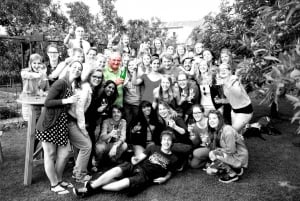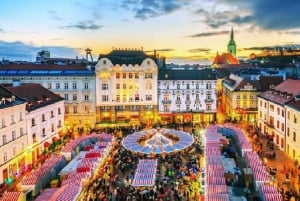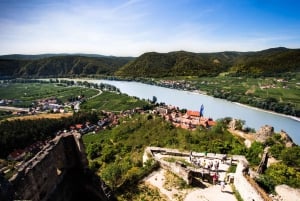Fountains of Bratislava
Maximilian's Fountain
The Maximilian's Fountain was built in 1572 in the Austrian stone workshop of Andreas Lutringer, with a financial contribution from Hungary's King Maximilian II. However, it is better known as Roland's Fountain. It consists of a massive circular tank 9 metres in diameter. In the middle of the tank stands a 10.5-metre-high column topped by a statue of a knight in armour said to represent the knight Roland, a legendary defender of the city's rights. Others consider this to be a statue of Maximilian II.
To this day, a legend still attaches to the fountain. The knight normally stands with his face turned towards the town hall. However, once a year, precisely at the stroke of midnight at New Year, he turns and bows in the direction of the former Town Hall, honouring the twelve councillors who in the past gave their lives in order to save the city. He is also rumoured to come to life on Good Friday.
On this occasion, he moves in broad daylight from his pedestal and waves his sword, , in all four directions, to show the town that it still enjoys his protection. Nevertheless, it is said that when he does so he can be seen only by a born-and-bred citizen of Bratislava, one with a pure heart who has never harmed anyone.
Ganymede's Fountain
This fountain was designed in 1888 by Bratislava-born Viktor Tilgner. It depicts figures from ancient mythology - an eagle carries the young Ganymede to the top of Mount Olympus, on the order of the Goddess Dia, so that he can serve the Gods.
On the upper part of the middle basin there are sculptures of aquatic creatures and, lower down, the central column is surrounded by figures of children holding four types of fish from the River Danube - carp, catfish, sander and pike. From the fishes' mouths water cascades into the basin. The figures on the fountain were cast by the firm A.M. Beschorner from Budapest.
Fountain of St. George and the Dragon
This Renaissance fountain in the courtyard of the Primatial Palace depicts the struggle of St. George and the Dragon. His life is part of the 'Golden Legend' which was extremely widespread in early Christian Europe. According to this legend, George was an officer in the Roman army who came upon a town terrorised by a dragon. In desperation, the people chose victims for the dragon by tossing a coin.
George intervened when the king's daughter had lost the toss and proceeded to kill the dragon with a spear. Whether George existed or not, he became a symbol of the battle against evil and a symbol of the conquest of Christianity over heathens.











